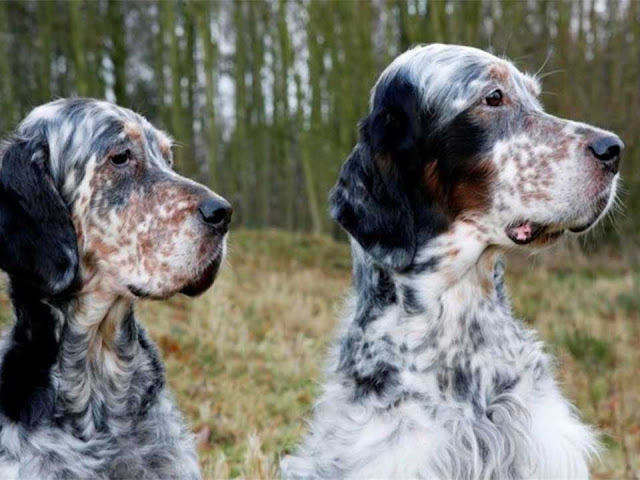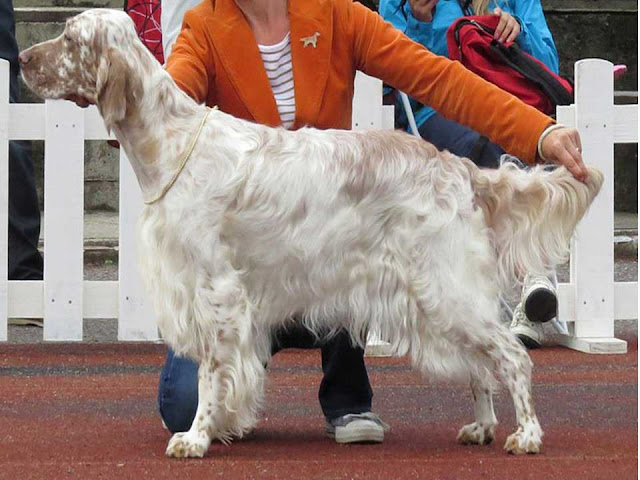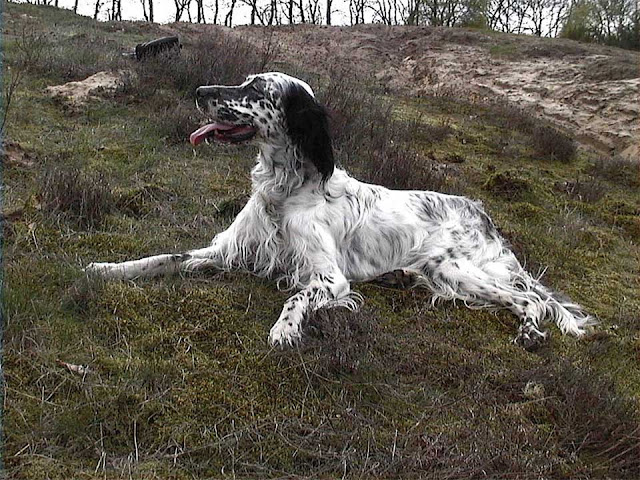Engelse Setter or English Setter
Engelse Setter or English Setter is a medium-sized dog breed from the setter group which comprises Red Irish Setters, Irish Red and White Setters, and black-and-tan Gordon Setters. Engelse Setter is basically a hunting dog. Descendant of the setting spaniels, Forward Dogs that were bred for the hunting of wild game at times when there were no gun-dogs yet. The dogs were the game, after which the hunters pulled the nets over the birds and the dogs. Edward Lavarack and Purcell Llewellyn develop a separate breed in the 19th century.
Did you know that not all dogs you meet on the street have an official pedigree? Pedigree dogs without a pedigree are called 'look-alikes'. Learn more about the difference between a ‘pedigree dog’ and a ‘look-alike’. Click What is a Pedigree Dog?'
Engelse Setters are usually weighing about 65 to 69 cm (25.5 to 27 inches) for males; and 61 to 65 cm (24 to 25.5 inches) for females. The normal weight ranges between 27 to 30 kilograms.
Lifespan
The average life of the Engelse Setter is 11 to 12 years.
Engelse Setter Appearance
English Setter or Engelse Setter is a medium-sized breed of dog which has a graceful appearance. The breed was produced to hunt games such as quail, pheasant, and grouse. So the dog should be able to cover a lot of ground when looking for the flying scent of birds, carrying its head high. The head of Engelse Setter should be marginally domed with a muzzle of good depth and display chiseling under the eyes, which should be dark in color with a kind and gentle appearance. The top of the ears (sometimes called ‘leathers’) are positioned in-line with the eyes. The English Setter has a long muscular neck, well-angled shoulders, and a brisket of good depth. The body length is moderate and well-balanced as compared to its height. The dog has robust powerful hindquarters. It carries its tail in-line with its back and the tail should be long enough to reach the hock.
Coat and Colors
There are different color variants. The basic color is White and Black (Blue Belton), Liver-colored or Orange and White (Orange Belton), Lemon and White (Lemon Belton), Liver and White (Liver Belton) or tricolor. The combination of white with black body stains and a brown neck, chin, and feet also occurs; this variant is called tricolor. The coat is generally slight curly, long, and silky from the back of head in-line with ears, breeches, and forelegs nearly down to feet well feathered. The generally white body coat is of medium length with silky fringes on the back of the legs, under the belly, and on the tail. The coat structures flecks of colors and the different color varieties are referred to as Belton. The dogs without heavy patches of color on the body, but with small spots all over the body are preferred.
The variations are not only distinguished in color but also in character; the Irishman is stubborn, the Scotsman robust, and the English are the gentleman. They are all excellent family dogs that are very fond of companionship. They can easily handle children and other dogs. Setters are generally not on guard (they like everyone) and should not be raised with a too hard hand. They need a lot of exercises, preferably favoring to run freely. Setters were originally bred mainly for the hunting of waterfowl, and therefore generally keep a dip in the water.
Engelse Setter Temperament
Engelse Setter is a powerful, elegant and particularly noble dog. The dog has a very gentle, calm, benign, and well-mannered character. Engelse Setter is less impulsive than the Irish Setter and less sturdy than the Gordon Setter. Engelse Setter is more famous in England, generally called ‘a gentleman by nature’. English Setters are active and people-oriented dogs. They are well suitable for families who can give them attention and activity. They are energetic dogs which require sufficient exercises. At least two-hour exercise a day is generally recommended for this breed.
Although strongly related to each other, the Engelse Setter is, in many ways, very different from the Irish Setter. Although the Irishmen see many as the most beautiful and most striking of the setter breeds, the Engelse Setter takes you in with his character. Soft, extremely polite and reliable, what you see is what you get, rarely have we experienced a fairer race of the Engelse Setter. When simply trained, they should be able to do jobs, chasing a field and having to stand for it.
FCI Information
FCI Group: 7 (Leading Dogs)
Section: 2.2
FCI Number: 2
Health Issues
The breed club; Association of lovers of the Engelse Setter is busy with the health of the Engelse Setter. This is part of the association breeding regulations of each breed club. They make the following studies compulsory for the parents: Hip dysplasia and Cochlear deafness. For the association breeding regulations and more information, you can contact the breed club.
Breed Club:
Association of Lovers of the Engelse Setter
Website: www.engelsesettervereniging.com
E-mail: mduch@telenet.be
Looking for an Engelse Setter Puppy?
Please contact the ‘Breed Club’ as mentioned above for a list of affiliated breeders, the current offer of puppies, and any adult dogs (replacements etc).
Registration History
When the American Kennel Club (AKC) was established in 1878, the Engelse Setters or English Setters along with 8 other sporting breeds, were recognized as the first purebred registration by the Club. The first dog registered at the club holding registration number “1” was an English Setter named ‘Adonis’. He was born in 1875 and registered as sired by ‘Leicester’ out of a bitch named ‘Dart’. His colors were given as black, white, and tan. He was possessed by his breeder George E. Delano of New Bedford, MA.
English Setters or Engelse Setters were particularly common in the United Kingdom during the 1960s, 1970s, and 1980s. The registration of puppies reached up to 1344 during 1974. In 2012, the Kennel Club of Great Britain registered the English Setter amongst the Vulnerable Native Breeds as only 234 puppies were listed. In 2002, there were 568 English Setter puppies listed at the club. However during 2012, the recorded number of English Setter puppies was increased up to 314, so the breed was moved to the Kennel Club's ‘At Watch’ list (breeds registration range 300–450). In 2015, the registration was declined to 289 resulting in a return to the Vulnerable Native Breeds list for 2016. The breed is still more popular as a working gundog in Italy. Even in Italy, however, the breed is in sharp decline, going from 20,999 registrations in 2002, to 14,510 in 2011. In contrast, the American Kennel Club (AKC) specified that 2011 was the ‘year of the setters, with all four making big jumps over the past year’. English Setters had previously ranked at #96 in 2015 but declined to #102 in 2016, but again get the position at #95 in 2017.
Also see: Lovely Pictures of English Setter Puppies or Engelse Setter Puppies





